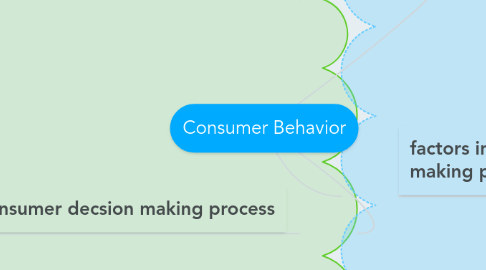
1. Consumer decsion making process
1.1. Need Recognition
1.1.1. when consumers recognize they have an unsatisfied need, and they would like to go from their actual, needy state to a different, desired state
1.1.1.1. Psychological Needs
1.1.1.1.1. pertain to the personal gratification consumers associate with a product and/or service.
1.1.1.2. Functional Needs
1.1.1.2.1. pertain to the performance of a product or service
1.2. information search
1.2.1. after a consumer recognizes a need, is to search for information about the various options that exist to satisfy that need.
1.2.1.1. Internal Search for Information
1.2.1.1.1. the buyer examines his or her own memory and knowledge about the product or service, gathered through past experiences.
1.2.1.2. External Search for Information
1.2.1.2.1. the buyer seeks information outside his or her personal knowledge base to help make the buying decision
1.3. Alternative Evaluation
1.3.1. Once a consumer has recognized a problem and explored the possible options, he or she must sift through the choices available and evaluate the alternatives
1.3.1.1. Consumer Decision Rules
1.3.1.1.1. et of criteria that consumers use consciously or subconsciously to quickly and efficiently select from among several alternatives.
1.4. Purchase and Consumption
1.4.1. customers are ready to buy
1.5. Postpurchase
1.5.1. The customers feelings after the purchase
1.5.1.1. customer loyalty
1.5.1.1.1. satisfied with their purchase and buy from the same company again.
1.5.1.2. Undesirable Consumer Behavior
1.5.1.2.1. consumers who don't repeat purchase or recommend the product to others.
2. involvement and consumer buying process
2.1. High involvement
2.1.1. Greater attention and deeper processing
2.1.1.1. develops strong attitudes and purchase intentions
2.2. Low involvement
2.2.1. Less attention and peripheral processing
2.2.1.1. creates weak attitudes
3. factors influencing the decision making process
3.1. Psychological Factors
3.1.1. Motives
3.1.1.1. a need or want that is strong enough to cause the person to seek satisfaction.
3.1.2. Attitude
3.1.2.1. a person's enduring evaluation of his or her feelings about and behavioral tendencies toward an object or idea
3.1.3. Perception
3.1.3.1. the process by which we select, organize, and interpret information to form a meaningful picture of the world
3.1.4. Learning
3.1.4.1. a change in a person's thought process or behavior that arises from experience and takes place throughout the consumer decision process.
3.1.5. Lifstyle
3.1.5.1. the way consumers spend their time and money to live
3.2. Social Factors
3.2.1. Family
3.2.1.1. Many purchase decisions are made about products or services that the entire family will consume or use.
3.2.2. Reference groups
3.2.2.1. one or more persons whom an individual uses as a basis for comparison regarding beliefs, feelings, and behaviors
3.2.3. Culture
3.2.3.1. the basis of the social factors that affect your buying decisions based on shared meanings, beliefs, morals, values, and customs of a group of people
3.3. Situational facotrs
3.3.1. purchase situation
3.3.1.1. underlying psychological trait or social factor that may change in certain purchase situations.
3.3.2. Shopping situation
3.3.2.1. when consumers are ready to purchase a product or service but become completely derailed once they arrive in the store.
3.4. Marketing mix
3.4.1. Product
3.4.2. Place
3.4.3. price
3.4.4. promotion
